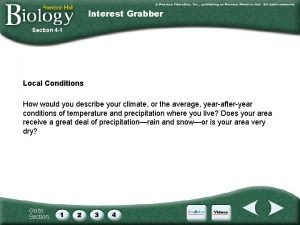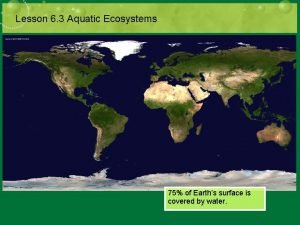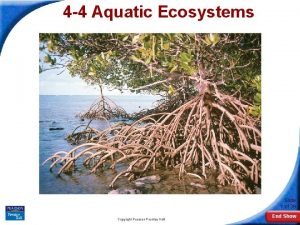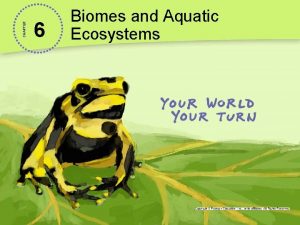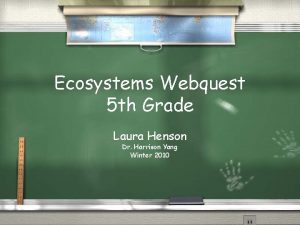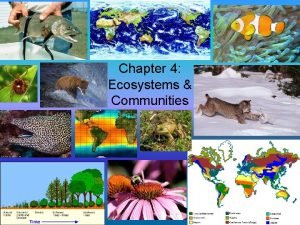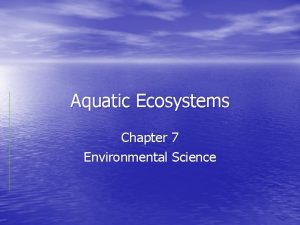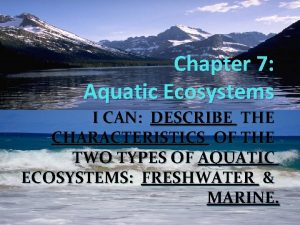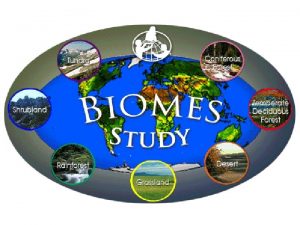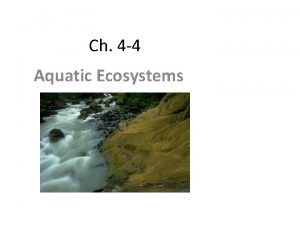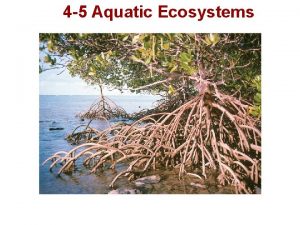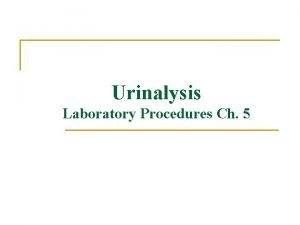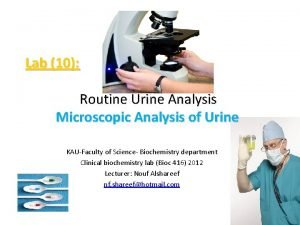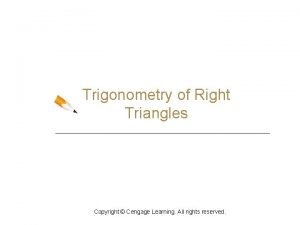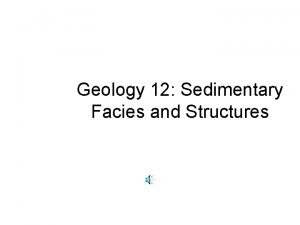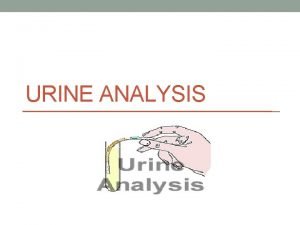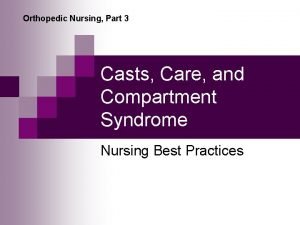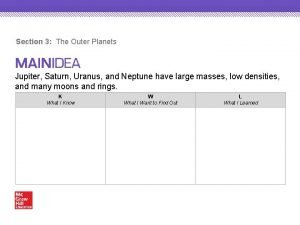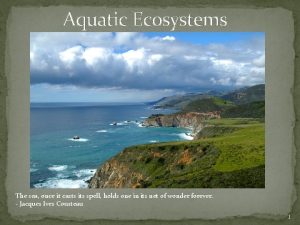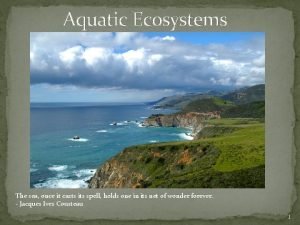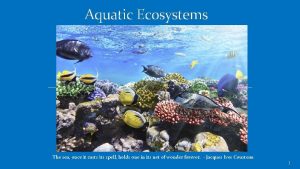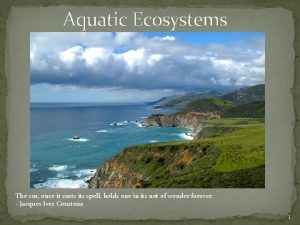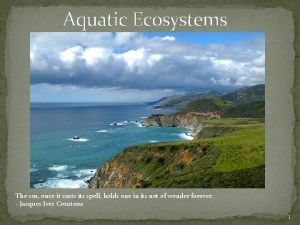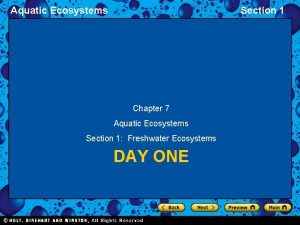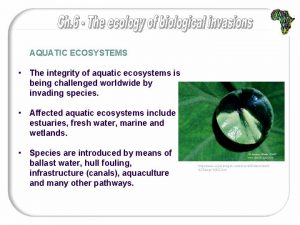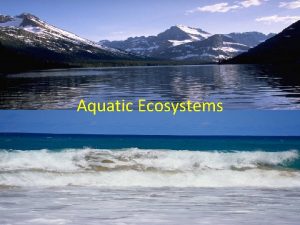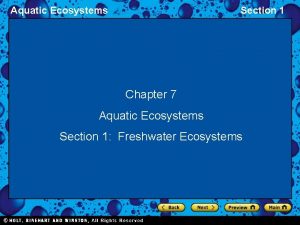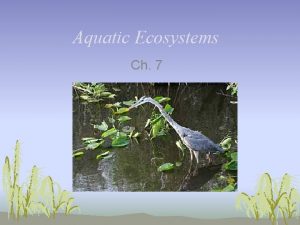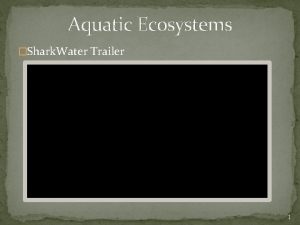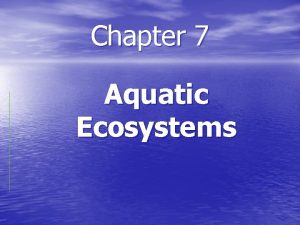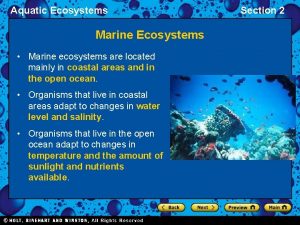Aquatic Ecosystems The sea once it casts its







































- Slides: 39

Aquatic Ecosystems The sea, once it casts its spell, holds one in its net of wonder forever. - Jacques Ives Cousteau 1

Aquatic Ecosystems �Aquatic ecosystems, like those on land, have a series of abiotic factors that influence what organisms can survive there. �Salinity is the amount of dissolved salt in the water. �Salt is formed when rainwater dissolves rocks, releasing minerals into the water. 2

�Water temperature, which is mostly influenced by sunlight. 3

�Availability of sunlight, which decreases with water depth. Bering Sea, 1300 ft below the surface. Oceandoctor. org 4

�Oxygen gas, which is dissolved in areas of turbulent water (waves and rapids). Whirlpool Rapids Gorge, Niagara River, NY 5

�Plant nutrients such as nitrates and phosphates, which runoff from land. Algae Blooms, Western Lake Erie 6

�Turbidity, or the cloudiness of the water, is caused by soil eroded from land. Confluence of Mississippi River(flows from right) and Minnesota River(flows from top) 7

Types of Aquatic Organisms �Plankton are free-floating or weakly swimming. �Phytoplankton are plant-like and include algae. �Zooplankton are animal-like, including organisms like single-celled protozoa or jellyfish. �Nekton are strong swimmers and consumers. �Fish, whales, sea turtles, etc. 8

�Benthos are bottom-dwellers that either anchor themselves to bottom structures or walk along the sea floor. �Sea stars, lobsters, mussels, etc. �Decomposers break down dead organisms and wastes into nutrients that can be reused. �Bacteria. 9

Lakes and Ponds �Lakes and ponds contain standing water, some of which is too deep for emergent vegetation. �Emergent vegetation includes plants that are rooted to the bottom and emerge above the water’s surface. �Lakes are larger than ponds, but there is no strict defined boundary. 10

�The littoral zone is near the shore and contains shallow, sunlit waters. �Emergent plants are found in this zone. �The limnetic zone is a photic open water area where rooted plants cannot survive. �Floating phytoplankton are the only photosynthetic organisms found here. �This zone extends only as deep as sunlight can penetrate. 11

�The profundal zone, directly below the limnetic zone, is aphotic, meaning is receives no sunlight. �The benthic zone is the bottom of the lake or pond. �Profundal and benthic zones have no producers. �Food webs are based around decomposers that feed from detritus (dead matter and waste) that falls down from above. �Oxygen levels are low, limiting the size of any nekton. 12

�Ecologists will classify lakes based on their nutrient levels and biological productivity. �Oligotrophic lakes are very low in nutrients, limiting plankton populations and leaving the water very clear. Mc. Donald Lake Glacier National Park Montana, United States 13

�Eutrophic lakes have much greater concentrations of nutrients, resulting in heavy growth of phytoplankton. Chesapeake Bay Maryland, United States 14

Rivers and Streams �Streams are narrow channels that carry small amounts of water. �Rivers are wider and carry more water. �Form when streams combine with runoff water from the surrounding land. Angel Falls, Bolivia 15

�Rivers are divided into zones, each with different characteristics. 16

�The source is the original point from which a river flows – a spring, lake, glacier, or wetland. �Characteristics of sources include: �High oxygen content �Low nutrient levels �Cold water temperature Source of the River Lison, Nans-sous-Sainte-Anne, France 17

�As the water moves through the transition zone, the streams widen, become deeper, and are warmed by the sun. �Oxygen levels decrease, temperature increases, and nutrient levels rise. �Low-lying areas, called the floodplains, will occasionally flood and deposit material from upstream. 18

�The river eventually ends at a larger body of water. This is called the river mouth. �Freshwater mixes with saltwater, forming brackish water. Moore River meets the Pacific Ocean, Australia 19

Freshwater Inland Wetlands �Freshwater wetlands have water that is regularly at or near the soil surface. �Marshes areas of low-lying wetland that do not support the growth of trees. �Swamps are wetlands that do support trees and dense shrubs. �Bogs have a floating mass of plant matter and a covering of sphagnum moss. Volo Bog Illinois, United States 20

�The mosses found in bogs secrete an acid that lowers the p. H of the water, slowing down decomposition significantly. �Scientists have discovered “bog bodies, ” remains of people preserved by the acids and other compounds released by the mosses in bogs. Tollund Man, a body discovered in 1950 of a man who died between 4 -300 B. C. E. 21

Marine Ecosystems �Marine ecosystems are in or near the oceans, and contain salty water. �Sunlight and nutrients are the two factors that most limit life in marine ecosystems. �The coasts tend to have the most biologically diverse ecosystems, with the open ocean having the least. 22

Coastal Wetlands �At the mouth of some rivers, sediment carried by the river will be deposited and form a landmass called a delta. �Estuaries are bodies of water partially-enclosed within deltas where seawater mixes with freshwater. 23

�A salt marsh is a coastal wetland regularly flooded by tides, and dominated by herbs, grasses, and shrubs. Low salt marsh, Great Bay, New Hampshire Photo from New Hampshire Division of Forests and Lands. 24

�Sea grass beds are wetlands with submerged plants that have long, narrow leaves that resemble grasslands. Sea grass bed, Bermuda. Photo from Government of Bermuda Ministry of Environment and Planning. 25

�Mangrove swamps have trees with complex root systems that can filter salt and withstand flooding and wave action. Mangrove swamp, Florida Everglades. 26

Ecosystem Services of Wetlands �Wetlands are biodiverse, meaning they support a wide variety of species of animals, plants, fungi, and protists. �Wetlands protect against flooding by absorbing and retaining excess water. �Wetlands trap pollutants, resulting in cleaner water that flows out of them. 27

Marine Aquatic Zones �In the coastal zone, life is plentiful due to an abundance of sunlight and nutrients. �About 90% of the ocean’s biodiversity is found in this zone. 28

�Rocky shores are found on coasts with heavy wave activity. �Sandy shores are found in areas with gentler wave action or that are sheltered. �Black sand is made from eroded volcanic rock. �Brown sand is made from eroded granite. �White sand is made from eroded coral. Mindanao Island, Philippines 29

�The intertidal zone is submerged during high tide and exposed during low tide. �The tides are caused by the gravitational pull of the moon and sun. 30

�Tidal range is the vertical difference between high and low tide. �The Bay of Fundy in Canada has the greatest tidal range at 16. 3 meters – taller than a 3 story building. 31

Shallow Seas �Shallow seas areas within the coastal zone between the continental shelf and the intertidal zone. �Reach a maximum depth of about 200 meters. �Receive enough sunlight to support photosynthetic plankton and algae. 32

Coral Reefs �Coral reefs are shallow sea ecosystems made from the skeletons of small animals called coral polyps that live in the warm coastal waters of the tropics and subtropics. �Coral polyps are a form a plankton that have a mutualistic relationship with algae. �The coral provides a home, the algae produce 90% of the polyp’s food through photosynthesis. 33

Open Ocean �The open ocean is the sunlit top layer of the ocean beyond the continental shelves. �Largest part of the ocean. �Moving away from the coast, the availability of nutrients decreases rapidly, greatly limiting the growth of photosynthetic plankton. �The open ocean is sometimes referred to as a “marine desert” due to the relative lack of life. 34

�The characteristics of the water in the open ocean change as you move downwards. �The photic (sunlight) zone contains sufficient sunlight for photosynthesis. �The dysphotic (twilight) zone sunlight, but not enough for photosynthesis. �The aphotic (midnight) zone is in complete darkness. 35

�Many species living in the aphotic and dysphotic zones are bioluminescent, meaning they can produce and emit light. �Light is produced through chemical reactions or by symbiotic bacteria. �The light can help to find prey or attract mates. 36

�The abyssal plain is the sea floor. �Food webs in the abyssal plain are based on scavenging and decomposition instead of photosynthesis. 37

�Marine snow is a shower of organic material that falls from the open water into the abyssal plain. �Decomposers and scavengers consume this material. 38

�Hydrothermal vents are fissures in the ocean floor where heated water and minerals are released into the water. �Certain organisms can use these compounds as a source of energy, in a process called chemosynthesis. 39
 Interest grabber
Interest grabber Lesson 3: aquatic ecosystems
Lesson 3: aquatic ecosystems Frog life cycle
Frog life cycle Lesson outline lesson 2 aquatic ecosystems answer key
Lesson outline lesson 2 aquatic ecosystems answer key 4 aquatic ecosystems
4 aquatic ecosystems 6 biomes and aquatic ecosystems answers
6 biomes and aquatic ecosystems answers Ecosystems webquest
Ecosystems webquest What factors describe aquatic ecosystems
What factors describe aquatic ecosystems Transitional aquatic ecosystems
Transitional aquatic ecosystems Chapter 7 aquatic ecosystems test answers
Chapter 7 aquatic ecosystems test answers Chapter 3 lesson 3 biomes and aquatic ecosystems
Chapter 3 lesson 3 biomes and aquatic ecosystems Section 4-4 aquatic ecosystems
Section 4-4 aquatic ecosystems Chapter 7 aquatic ecosystems
Chapter 7 aquatic ecosystems Aquatic ecosystems webquest
Aquatic ecosystems webquest Biomes and aquatic ecosystems
Biomes and aquatic ecosystems 4-4 aquatic ecosystems
4-4 aquatic ecosystems 4-4 aquatic ecosystems
4-4 aquatic ecosystems Savanna biome plants
Savanna biome plants Casts in urine
Casts in urine Centrifuged
Centrifuged Special triangle chart
Special triangle chart Perfect love casts out fear
Perfect love casts out fear Flute casts flow direction
Flute casts flow direction Urine contains
Urine contains Solving right angles
Solving right angles The chestnut casts his flambeaux
The chestnut casts his flambeaux Ua hyaline casts/lpf qn
Ua hyaline casts/lpf qn Rbc
Rbc Right triangle word problems
Right triangle word problems Gauntlet cast ortho
Gauntlet cast ortho Marlin symbolism
Marlin symbolism Led soldiers across hellespont into anatolia goals
Led soldiers across hellespont into anatolia goals Sea stack sea arch
Sea stack sea arch Yellow sea and east china sea
Yellow sea and east china sea Hydra jellyfish
Hydra jellyfish Jupiter spins once on its axis in a little less than
Jupiter spins once on its axis in a little less than Emigree
Emigree Its halloween its halloween the moon is full and bright
Its halloween its halloween the moon is full and bright When a train increases its velocity its momentum
When a train increases its velocity its momentum Its not easy but its worth it
Its not easy but its worth it
